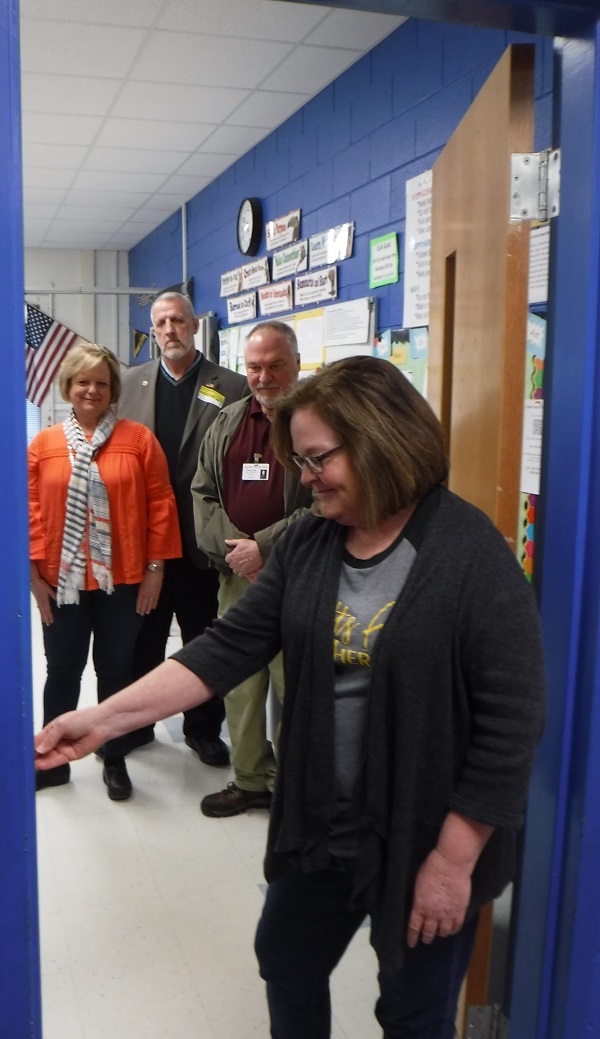
BY KARISSA MILLER
With a simple hand movement, a small metal plate latches into a hole as Scotts Elementary teacher Carol Holt demonstrates how quickly the lock provides protection.
“If we have a lockdown, we don’t have to fumble with our keys. It’s very user friendly and it speeds up the process up (of securing the room),” Holt said. “Nobody can push the door open and we feel safe.”
Scotts Principal LeAnne Hall said RhinoWare door barricade locks were installed over the holiday break in almost all of their classrooms and office doors. The locks are designed to quickly protect students and teachers from anyone who is invading the school.
Hall said that she met with a prospective kindergarten family Thursday and that one of their first questions was about safety and security. She demonstrated the new lock system.
“That comforted and built trust with these family members,” she recalled.
With a part-time School Resource Officer at their school and the locks in place, the staff feels more safe and secure than ever, Hall said.
School administrators have wanted locks, but was unable to fund them on their own.
By the end of February, all Iredell-Statesville Schools will have the RhinoWare door barricade locks on classrooms and office buildings.
The locks are being funded out of a special public safety fund established by the Iredell County Board of Commissioners.
Superintendent Brady Johnson said that following the school shooting in Parkland, Florida, I-SS officials began looking at ways to improve security in schools across the district.
Ten I-SS elementary campuses has already installed the RhinoWare barricades on their doors so the school system chose to add them in the rest of the schools. The barricades are also used by some county agencies.
District officials are committed to meeting with the 10 schools, who funded the locks through their Parent Teacher Organizations, to pay for another project to make it equitable, Johnson said.
A total of 27 schools will receive the same locks in their classrooms to ensure safety on each campus, said Mike James, I-SS’ safety and compliance officer.
The number of locks will vary based on the size of the school. “It could range somewhere from 40 to 140 locks,” he explained.
“Our No. 1 priority is their safety and wellbeing,” James said. “It’s just an added layer of security to keep staff and students safe in case there is an intruder — the locks make the door harder to penetrate.”
The cost of installing RhinoWare on 27 campuses is approximately $160,000, officials stated.
The county’s public safety fund also pays for cameras, communication upgrades, social media monitoring software and other capital safety improvements, such as fencing.
School Safety Task Force
Commissioner Gene Houpe said after the ¼-cent sales tax failed, the school safety and security task force negotiate a bulk rate for the locks in an effort to save money.
“All of these kids are equally important to us. We cannot afford to put a SRO (School Resource Officer) in every school. We can’t afford to put a mental health professional in every school, but we’re tackling all of these things as we can,” Houpe said.
This year, elementary school SROs are split between two schools; meanwhile, all middle and high schools have at least one SRO in their building.
There are other proactive measures being carried out by law enforcement and other agencies, but they are kept confidential.
“We don’t always advertise all the safety measures because we don’t want criminals to know all we’re doing,” Houpe said.
Houpe, who has children in the school system, said he’s very concerned about the suicides and mental health issues that are increasingly prevalent in the schools.
He said that we cannot continue to lose kids to suicide. However, the county safety and security fund cannot pay for things like mental health counselors and school nurses.
Finding money
The district received two federal grants this school year totaling $12.1 million. Some of those funds will pay for additional mental health resources and nurses.
The grant will span five years, Johnson said, mentioning that the school board will be tasked with finding a way to continue to fund those initiatives once the grant funding ends.
Factored in with expiration of the grant in five years is the complex school budget.
I-SS School Board Chairman Martin Page pointed out that there’s no new revenue source for this special fund. It’s money that’s been shifted out of the school’s capital budget and additional money out of the county commissioners’ budget.
The safety and security fund was created by taking ½-cent of the county commissioner’s general fund budget and ½-cent of capital money (or funds that are set aside for capital projects for the schools) and combining that into one new budget item.
Page also mentioned that one downside is that the school board will have to continue to move money out of its capital fund, which could fund building and maintenance projects, to pay for safety security and student well-being efforts.
“In other words, we’re robbing Peter to pay Paul,” Page said.
Each year, the school board and administrators have had to scramble to avoid layoffs and other cuts. The board has been unable to close the gap that exists between the amount they receive from the county commissioners in their local budget with what’s being asked or mandated by the state.
Salary increases, for example, are determined by the state, but the school board must cover increased benefit costs while balancing the needs of the system.
I-SS has been unable to restore many vital positions, including Teacher Assistants, maintenance and social workers, that were cut due to the recession several years ago. The problem is not unique to Iredell County, but it’s become a struggle for many school districts statewide.



